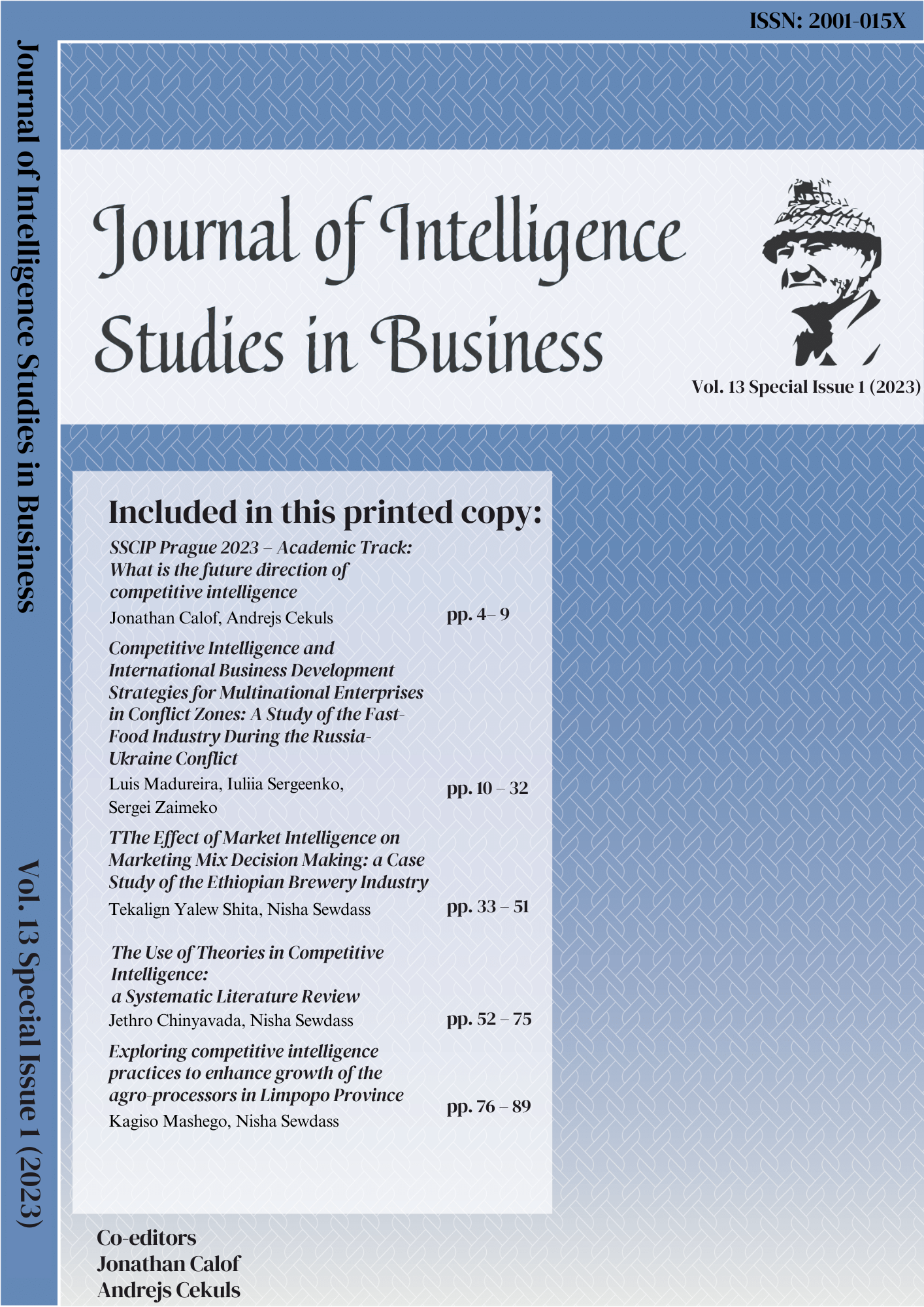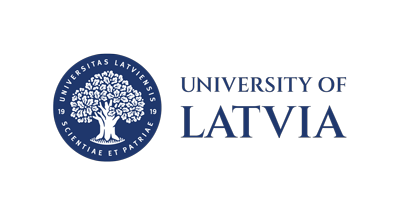Competitive Intelligence and International Business Development Strategies for Multinational Enterprises in Conflict Zones: A Study of the Fast-Food Industry During the Russia-Ukraine Conflict
DOI:
https://doi.org/10.37380/jisib.v13si1.1133Keywords:
case study, frameworks, geopolitical conflicts, strategic decision-making, VUCAAbstract
This study delves into the pivotal role of Competitive Intelligence (CI) in shaping International Business Development (IBD) strategies for multinational enterprises (MNEs) operating in the fast-food industry amidst the geopolitical turbulence of the Russia-Ukraine conflict. It addresses a critical gap in existing research by examining how CI influences strategic decision-making in conflict-affected zones. The research is anchored on the premise that traditional IBD frameworks exhibit limitations when applied to unstable geopolitical contexts, necessitating a nuanced understanding of the interplay between CI and IBD in such environments. Employing a mixed-methods approach, the study integrates a comprehensive literature review with case studies and empirical data analysis. It particularly leverages the Competitive Intelligence Funnel framework to assess both external and internal business factors that influence strategic decisions. This methodology facilitates a holistic examination of the strategic manoeuvres of prominent fast-food corporations, including McDonald’s, YUM! Brands, and Subway, in response to the conflict. The findings reveal that these MNEs employed adaptive strategies in various domains such as marketing, supply chain management, corporate social responsibility, and investment decisions. Notably, the study uncovers a significant reliance on real-time geopolitical analysis and ethical considerations in strategy formulation, underscoring the limitations of conventional IBD models in conflict scenarios. Conclusively, the research posits that existing IBD frameworks require integration with real-time geopolitical insights and ethical considerations to be effective in conflict zones. This study contributes to the academic discourse by highlighting the indispensability of CI in the strategic planning of MNEs in volatile environments. It provides a novel perspective on the dynamic relationship between CI and IBD strategies, offering valuable insights for both scholars and practitioners in the realms of international business and strategic management.
References
Aguilar, F. J. (1967). Scanning the business environment (1st THUS). Macmillan.
Amburgey, T. L., Kelly, D., & Barnett, W. P. (990). Resetting the clock: The dynamics of organizational change and failure. Academy of Management Proceedings, 1990(1), 160–164. https://doi.org/10.5465/ambpp.1990.4978494 DOI: https://doi.org/10.5465/ambpp.1990.4978494
Barnett, M. L. (2003). Falling off the fence? A realistic appraisal of a real options approach to corporate strategy. Journal of Management Inquiry, 12(2), 185–196. https://doi.org/10.1177/1056492603253040 DOI: https://doi.org/10.1177/1056492603012002012
Bennett, N., & Lemoine, J. (2014). What a difference a word makes: Understanding threats to performance in a VUCA world. Business Horizons, 57(3), 311–317. https://doi.org/10.1016/j.bushor.2014.01.001 DOI: https://doi.org/10.1016/j.bushor.2014.01.001
Boddewyn, J. J., & Brewer, T. L. (1994). International-business political behavior: New theoretical directions. Academy of Management Review, 19(1), 119–143. https://doi.org/10.2307/258837 DOI: https://doi.org/10.2307/258837
Brandon‐Jones, E., Squire, B., Autry, C. W., & Petersen, K. J. (2014). A contingent resource‐based perspective of supply chain resilience and robustness. Journal of Supply Chain Management, 50(3), 55–73. https://doi.org/10.1111/jscm.12050 DOI: https://doi.org/10.1111/jscm.12050
Brouthers, K. D. (2002). Institutional, cultural and transaction cost influences on entry mode choice and performance. Journal of International Business Studies, 33(2), 203–221. https://doi.org/10.1057/palgrave.jibs.8491013 DOI: https://doi.org/10.1057/palgrave.jibs.8491013
Brouthers, K. D., Brouthers, L. E., & Werner, S. (2002). Industrial sector, perceived environmental uncertainty and entry mode strategy. Journal of Business Research, 55(6), 495–507. https://doi.org/10.1016/S0148-2963(00)00154-5 DOI: https://doi.org/10.1016/S0148-2963(00)00154-5
Chandler, D. (2015). Corporate social responsibility: a strategic perspective (1st ed.). Business Expert Press.
Collinson, S., Narula, R., & Rugman, A. M. (2017). International business (7th edition). Pearson.
Colvin, G. (2022). Inside Mcdonald’s decision to sell all 853 stores in Russia. Fortune. https://fortune.com/2022/07/27/mcdonalds-closing-all-stores-russia-revenue-employees/?utm_source=email&utm_medium=newsletter&utm_campaign=ceo-daily&utm_content=2022072809am&tpcc=nlceoi
Cuervo-Cazurra, A., Narula, R., & Un, C. A. (2015). Internationalization motives: sell more, buy better, upgrade and escape. Multinational Business Review, 23(1), 25–35. https://doi.org/10.1108/MBR-02-2015-0009 DOI: https://doi.org/10.1108/MBR-02-2015-0009
Daft, R. L., Sormunen, J., & Parks, D. (1988). Chief executive scanning, environmental characteristics, and company performance: an empirical study. Strategic Management Journal, 9(2), 123–139. https://doi.org/10.1002/smj.4250090204 DOI: https://doi.org/10.1002/smj.4250090204
Dunning, J. H. (2000). The eclectic paradigm as an envelope for economic and business theories of MNE activity. International Business Review, 9(2), 163–190. https://doi.org/10.1016/S0969-5931(99)00035-9 DOI: https://doi.org/10.1016/S0969-5931(99)00035-9
Eisenhardt, K. M. (1989). Making fast strategic decisions in high-velocity environments. Academy of Management Journal, 32(3), 543–576. https://doi.org/10.5465/256434 DOI: https://doi.org/10.2307/256434
Eisenhardt, K. M., Furr, N. R., & Bingham, C. B. (2010). Microfoundations of performance: Balancing efficiency and flexibility in dynamic environments. Organization Science, 21(6), 1263–1273. https://doi.org/10.1287/orsc.1100.0564 DOI: https://doi.org/10.1287/orsc.1100.0564
Eisenhardt, K. M., & Martin, J. A. (2000). Dynamic capabilities: What are they? Strategic Management Journal, 21(10‐11), 1105–1121. https://doi.org/10.1002/1097-0266(200010/11)21:10/11<1105::AID-SMJ133>3.0.CO;2-E DOI: https://doi.org/10.1002/1097-0266(200010/11)21:10/11<1105::AID-SMJ133>3.0.CO;2-E
Fahey, L., & King, W. R. (1977). Environmental scanning for corporate planning. Business Horizons, 20(4), 61–71. https://doi.org/10.1016/0007-6813(77)90010-6 DOI: https://doi.org/10.1016/0007-6813(77)90010-6
Ghemawat, P. (2001). Distance still matters. Harvard Business Review, 79(8), 137–147.
Hak, T., & Dul, J. (2009). Pattern matching (SSRN Scholarly Paper No. 1433934). https://papers.ssrn.com/abstract=1433934
Hambrick, D. C. (1981). Environment, strategy, and power within top management teams. Administrative Science Quarterly, 26(2), 253–275. https://doi.org/10.2307/2392472 DOI: https://doi.org/10.2307/2392472
Hillemann, J., & Gestrin, M. (2016). The limits of firm-level globalization: revisiting the FSA/CSA matrix. International Business Review, 25(3), 767–775. https://doi.org/10.1016/j.ibusrev.2016.01.018 DOI: https://doi.org/10.1016/j.ibusrev.2016.01.018
Jacobides, M. G. (2023). Ecosystems for the rest of us. Strategy+business. https://www.strategy-business.com/article/Ecosystems-for-the-rest-of-us
Jacobides, M. G., Cennamo, C., & Gawer, A. (2018). Towards a theory of ecosystems. Strategic Management Journal, 39(8), 2255–2276. https://doi.org/10.1002/smj.2904 DOI: https://doi.org/10.1002/smj.2904
Jamali, D., & Mirshak, R. (2007). Corporate Social Responsibility (CSR): Theory and Practice in a Developing Country Context. Journal of Business Ethics, 72, 243–262. https://doi.org/10.1007/s10551-006-9168-4 DOI: https://doi.org/10.1007/s10551-006-9168-4
Johanson, J., & Vahlne, J.-E. (1977). The internationalization process of the firm: A model of knowledge development and increasing foreign market commitments. Journal of International Business Studies, 8, 23–32. https://doi.org/10.1057/palgrave.jibs.8490676 DOI: https://doi.org/10.1057/palgrave.jibs.8490676
Katsikeas, C. S., Leonidou, L. C., & Samiee, S. (2009). Research into exporting: Theoretical, methodological, and empirical insights. In The SAGE Handbook of International Marketing (pp. 165–182). SAGE Publications Ltd. https://doi.org/10.4135/9780857021007 DOI: https://doi.org/10.4135/9780857021007.n8
Kobrin, S. J. (1982). Managing political risk assessment: Strategic response to environmental change (1st ed.). University of California Press. DOI: https://doi.org/10.1525/9780520310094
Liu, J. (2017). The future of social intelligence is in the enterprise, not marketing social listening platforms flourish when they’re no longer an island (No. 136965). Forrester. https://www.forrester.com/report/the-future-of-social-intelligence-is-in-the-enterprise-not-marketing/RES136965
Madureira, L. (2014). Market and competitor analysis: Real exercise. In W. J. Lahneman & R. Arcos (Eds.), The Art of Intelligence: Simulations, Exercises, and Games (1st ed., Vol. 125, pp. 125–142). Rowman & Littlefield. https://rowman.com/ISBN/9781442228979/The-Art-of-Intelligence-Simulations-Exercises-and-Games
Madureira, L. (2023). Competitive intelligence science: Unified view, modular definition, instruments, and mindset [PhD Dissertation - Information Management, NOVA Information Management School (IMS)]. https://run.unl.pt/handle/10362/155564
Madureira, L., Popovic, A., & Castelli, M. (2021). Competitive intelligence: A unified view and modular definition. Technological Forecasting and Social Change, 173(December 121086), 1–17. https://doi.org/10.1016/j.techfore.2021.121086 DOI: https://doi.org/10.1016/j.techfore.2021.121086
Madureira, L., Popovic, A., & Castelli, M. (2023). Competitive intelligence empirical validation and application: Foundations for knowledge advancement and relevance to practice. Journal of Information Science, 1–24. https://doi.org/10.1177/01655515231191221 DOI: https://doi.org/10.1177/01655515231191221
Manuj, I., & Mentzer, J. T. (2008). Global supply chain risk management strategies. International Journal of Physical Distribution & Logistics Management, 38(3), 192–223. https://doi.org/10.1108/09600030810866986 DOI: https://doi.org/10.1108/09600030810866986
MarketLine. (2023). Food & grocery retail industry profile: Russia. Retrieved from Business Source Complete database.
Narula, R. (2014). Globalization and technology: interdependence, innovation systems and industrial policy (1st ed.). John Wiley & Sons.
Peng, M. W. (2001). The resource-based view and international business. Journal of Management, 27(6), 803–829. https://doi.org/10.1177/014920630102700611 DOI: https://doi.org/10.1016/S0149-2063(01)00124-6
Porter, M. E. (1980). Competitive strategy: Techniques for analyzing industries and competitors (1st ed.). Free Press.
Power, D. J. (1986). Strategic management skills. Addison-Wesley Pub. Co.
Prescott, J. E. (1999). The evolution of competitive intelligence. Designing a process for action. Proposal Management (Journal of the Association of Proposal Management Professionals), Spring, 37–52.
Reeves, M., Lotan, H., Legrand, J., & Jacobides, M. G. (2019). How business ecosystems rise (and often fall). MIT Sloan Management Review, 60(4), 1–6. https://mitsmr.com/333bZ5Q
Statista. (2022a). Fast food market volume in Russia 2021 (p. 1). Statista. https://www-statista-com.skema.idm.oclc.org/statistics/1292287/fast-food-market-volume-russia/
Statista. (2022b). Highest earning catering companies in Russia 2021 (p. 1). Statista. https://www-statista-com.skema.idm.oclc.org/statistics/1326523/highest-earning-catering-companies-russia/
Teece, D. J. (2007). Explicating dynamic capabilities: The nature and microfoundations of (sustainable) enterprise performance. Strategic Management Journal, 28(13), 1319–1350. https://doi.org/10.1002/smj.640 DOI: https://doi.org/10.1002/smj.640
Teece, D. J. (2017). Dynamic capabilities and the multinational enterprise. In B. J. Christensen & C. Kowalczyk (Eds.), Globalization (pp. 105–129). Springer Berlin Heidelberg. https://doi.org/10.1007/978-3-662-49502-5_5 DOI: https://doi.org/10.1007/978-3-662-49502-5_5
Wheelen, T. L., Hunger, J. D., Hoffman, A. N., & Bamford, C. E. (2018). Strategic management and business policy globalization, innovation and sustainability (15th ed.). Pearson Education Limited. https://doi.org/1-292-21548-8
Yin, R. K. (2003). Case study research: Design and methods (3rd ed., Vol. 5). Sage Publications.
Downloads
Published
Issue
Section
License
Copyright (c) 2023 Journal of Intelligence Studies in Business

This work is licensed under a Creative Commons Attribution-NonCommercial-NoDerivatives 4.0 International License.
Authors who publish with this journal agree to the following terms:
- Authors retain copyright and grant the journal right of first publication with the work simultaneously licensed under a Creative Commons Attribution License that allows others to share the work with an acknowledgement of the work's authorship and initial publication in this journal.
- Authors are able to enter into separate, additional contractual arrangements for the non-exclusive distribution of the journal's published version of the work (e.g., post it to an institutional repository or publish it in a book), with an acknowledgement of its initial publication in this journal.
- Authors are permitted and encouraged to post their work online (e.g., in institutional repositories or on their website) prior to and during the submission process, as it can lead to productive exchanges, as well as earlier and greater citation of published work (See The Effect of Open Access).








